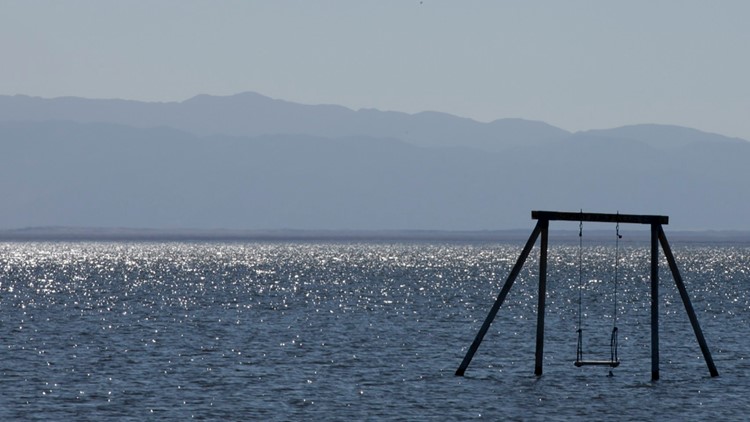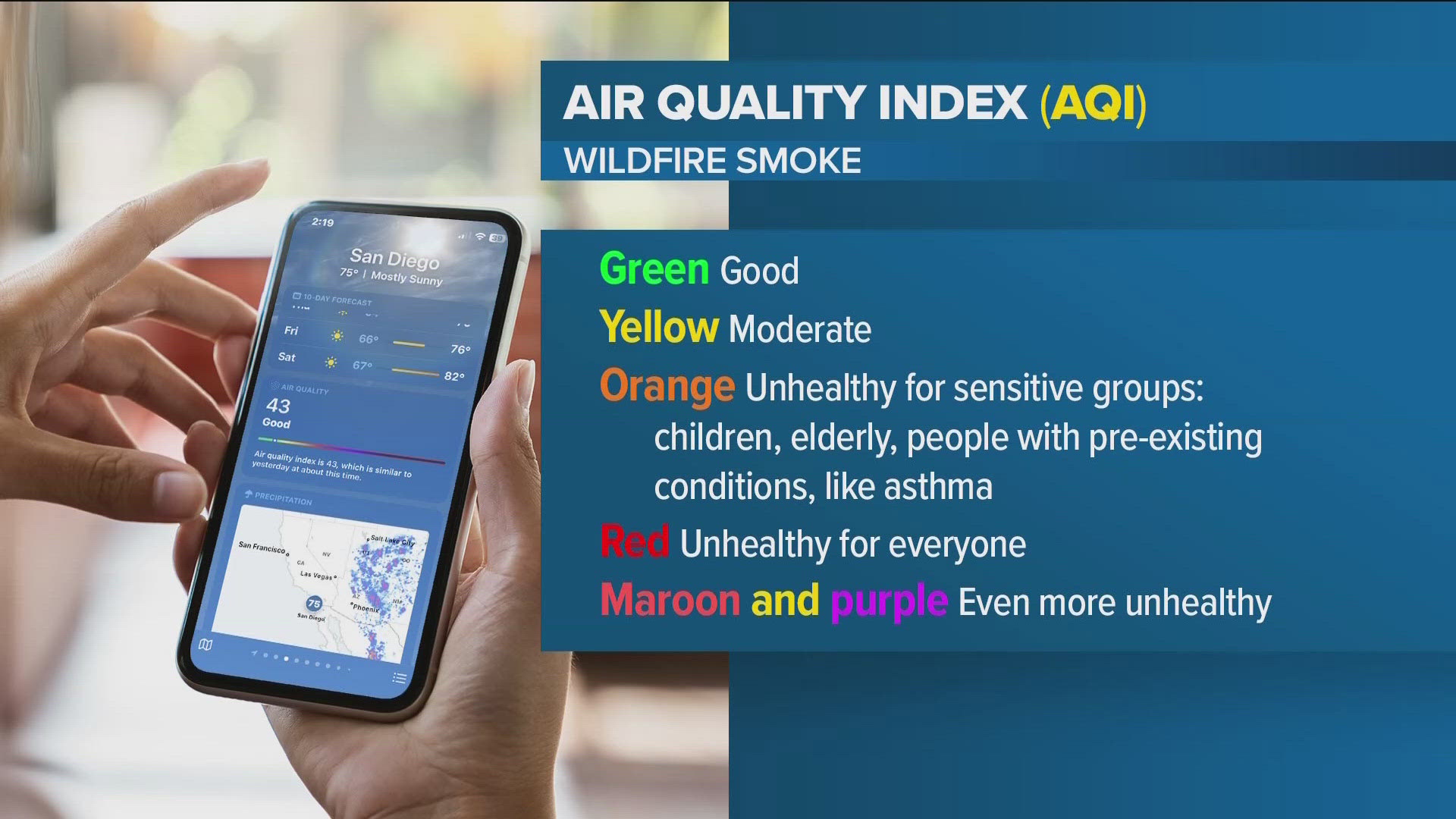California’s desert is littered with remnants of broken dreams — hidden ghost towns, abandoned mines and rusty remains of someone’s Big Idea. But nothing looms larger on an abandoned landscape than the Salton Sea, which languishes in an overlooked corner of the state.
The water shimmers and broils in the desert like a rebuke: born of human error, made worse by 100 years of neglect and pollution. California’s largest lake is also one of its worst environmental blights, presenting a problem so inverted that its toxic legacy intensifies as its foul water disappears.
For generations, Imperial Valley residents have been breathing in a Periodic Table of minerals and metals, as well as agricultural chemicals. But for all the misery that these receding waters have unleashed — asthma and other respiratory ailments triggered by dust clouds — the Salton Sea now offers a potential way out: A bounty of lithium, called “white gold,” one of the planet’s most prized elements, used to manufacture batteries that power electric cars and drive a fossil-fuel-free future.
And the state of California wants to be in on it.

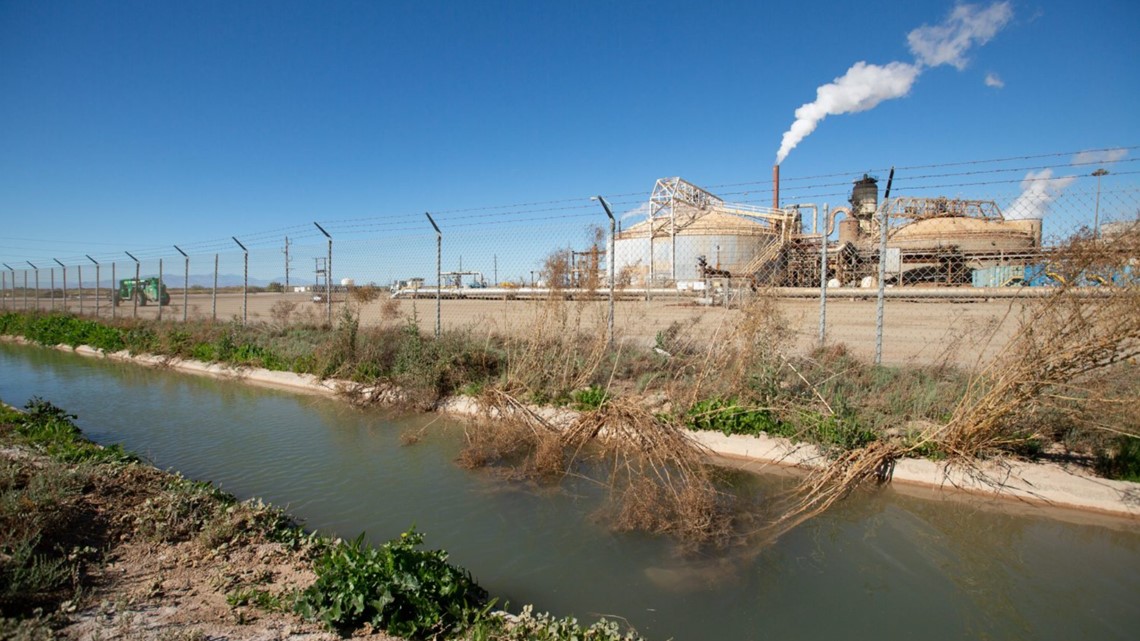
The California Energy Commission has stepped in as an angel investor, doling out $16 million in grants to a handful of companies to determine if it’s technically and commercially feasible to extract lithium from the brine that geothermal plants are already pulling from the Salton Sea.
One of the recipients, CalEnergy Resources, a subsidiary of the giant Berkshire Hathaway Energy Renewables, is using $6 million in state grants to piggy-back a lithium-extraction pilot project onto its existing geothermal plants near Calipatria, at the southeast end of the dying sea. The company, which expects to break ground soon, will build a small-scale demonstration plant to begin operating next year. Should all go well, it envisions that it could eventually produce nearly a third of the world’s lithium.
From the standpoint of California public policy, the project offers a unique intersection of two state priorities: increasing sources of renewable energy and encouraging new battery technology for electric cars and energy storage. The state’s target for electric cars, for example, could use a boost. Gov. Gavin Newsom last year directed the state to ban all new gasoline-powered cars by 2035.
Assemblymember Eduardo Garcia, a Democrat from Coachella, gave the idea a jump start last year, writing a law that created the Lithium Valley Commission, an optimistic reference to the economic juggernaut that is Silicon Valley. The blue-ribbon commission members, appointed by state agencies, legislators and the governor, hold their first meeting today, and will file a report to lawmakers next year.
State officials envision not just lithium extraction and power plants, but also constructing links along the supply chain, battery-building facilities, electric vehicle manufacturing plants and everything else local authorities can dream of.

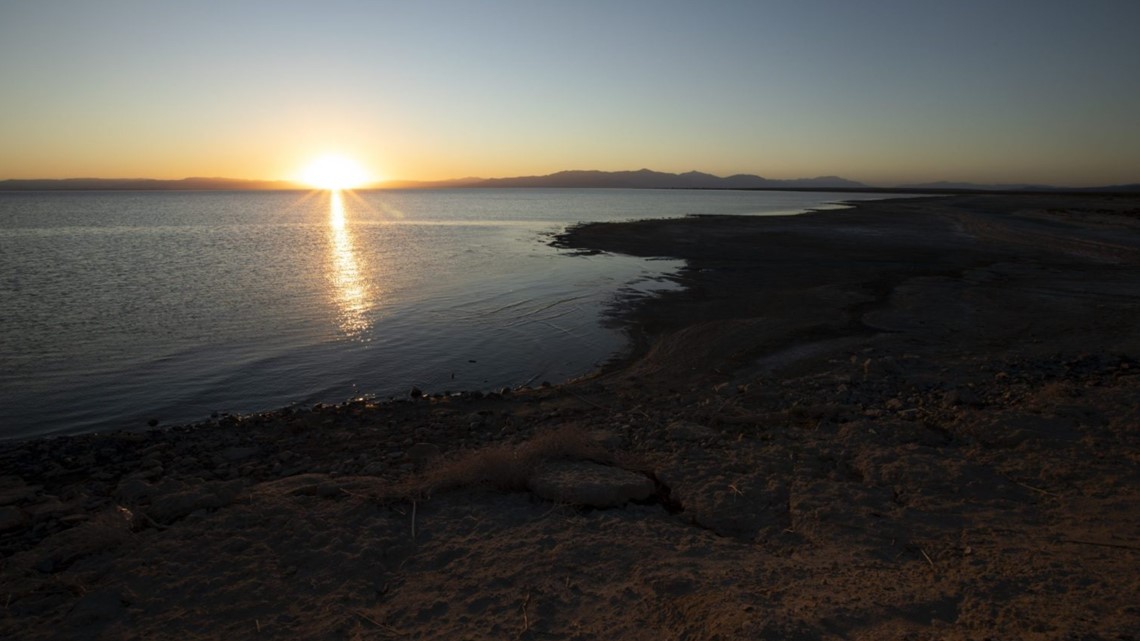
Such an expansive project would transform the entire Imperial Valley, home to 174,000 people, 85% Latino, who face chronically high unemployment and few job opportunities outside farm fields.
But environmental justice advocates worry about the potential impacts of additional waste and air pollution from extracting and processing lithium at the Salton Sea. Since it’s an experimental technology, the environmental effects have not been analyzed yet.
The Imperial Valley already is perennially ranked at the top of California’s most polluted places — with all the serious health problems that go along with it.
“Disadvantaged communities are always going to be on the losing end,” said Luis Olmedo, executive director of Comite Civico Del Valle, a health and social services organization in Brawley.
“Do we see opportunity for jobs, do we see opportunity for economic benefit for community development? We see all of that, but unfortunately the way the system is set up right here in this region, the monies are not reaching those vulnerable disadvantaged populations.”
On the ‘Toxic Tour’
Geothermal plants at the Salton Sea, with their huffing stacks and snaking pipelines, are difficult to miss, jutting up from the Imperial Valley’s flat desert floor.
Getting to the facilities requires negotiating narrow county roads bordering alfalfa fields and past teeming cattle feedlots. But the out-of-the-way plants are not out-of-mind to valley residents. They are included on a local group’s “Toxic Tour” when state officials come to town.

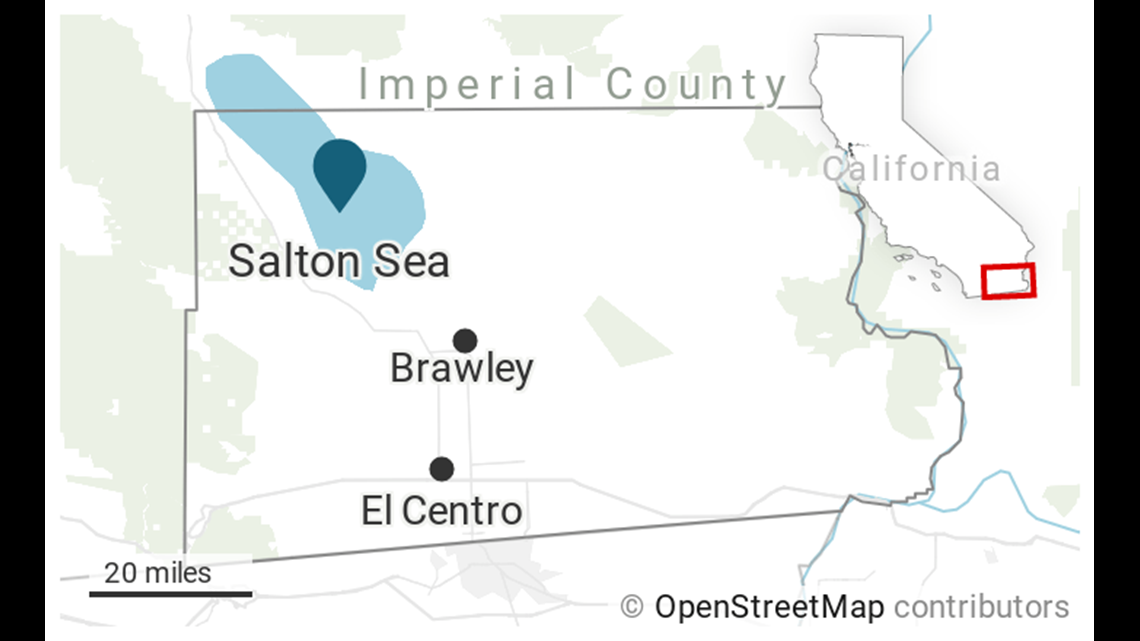
Even as Garcia ushers in a project that could invigorate the economy of his ailing district, he is adamant that whatever future industry materializes, it cannot make things worse in the environmentally-challenged region.
“One of the main principles is to do no harm,” Garcia said. “A lot of information is still to be gathered and understood before we are able to determine that this is going to be the best thing to happen and will have the return investment from a social, human health, economic perspective. Otherwise, we are not meeting the overall goals.
“It would do us no good if all we were doing is extracting the minerals and leaving behind an environmental mess on top of an existing mess that we are making strides to address. We cannot regress.”


This “mess” was created in 1905, when engineers cut into the west bank of the Colorado River, diverting water to slake the thirst of Imperial County’s agricultural field. Water sluiced into the valley. Heavy flooding overwhelmed the man-made channels, and for two years the river ran unimpeded into the Salton Basin.
The floodwaters were tamed, but the great lake, cut off from its freshwater supply, began the inexorable process of evaporating and receding. It stayed alive with surplus agricultural water and runoff, but the tainted water that fed the sea began to lay down generations of toxic sludge buried in sediment.
Fish died, migratory birds that fed on them detoured and the yacht clubs, marinas and shoreline vacation homes were left stranded in muck. The exposed lake bed’s mineral-laden soil is whipped by frequent winds, and the dust clouds contribute to the region’s chronic respiratory health problem.
Today the Salton Sea’s nearly 350 square miles of shallow water remains one of the state’s most stubborn and expensive repair jobs, and as each new restoration plan is unveiled but not implemented, the legacy continues to make residents sick.
“The community faces high rates of asthma and respiratory conditions that have been existing ever since this valley was created. You have all different sources of pollution, the sea being one of the strongest ones, and the (geothermal) plants out there,” said Miguel Hernandez, co-chair of the Environmental Justice Enforcement Task Force for Imperial Valley and the Eastern Coachella Valley.
Anyssa Garcia has lived in Brawley, population 26,000, a dozen miles from the southern edge of the Salton Sea, her entire 21 years. Her family and friends are frequently sick with respiratory illness.
“My mom and my cousins have asthma, I see the struggle they go through,” she said. “Everyone carries an inhaler. I’m paying more attention to the air we breathe now.”
According to University of Southern California researchers, Imperial County’s children visit emergency rooms and are hospitalized for asthma at double the rate of the state average. Another measure shows double the state rate of active asthma among adults older than 65.
Anyssa Garcia said the environmental problems are so intractable that she longs to join the diaspora of young people away from the valley.
“I’ve never seen my family struggle like this,” she said. “I would love to get out of this valley, the conditions here are very unhealthy.”
State officials just launched a $200 million wetlands and air quality project, part of a pledge to spend nearly a half-billion dollars to restore the lake for fish and birds and cover the exposed playa to control the dust.
The lithium extraction efforts are not connected to the Salton Sea restoration projects, but there is a great temptation to conflate them and imagine how the lithium bonanza might improve the health of both the lake and those who live around it. At least one geothermal developer has floated the idea of contributing to a long-term fund dedicated to lake remediation.
To David Hochschild, chairman of the California Energy Commission, it’s inevitable, and even fitting, that the Salton Sea’s lithium windfall might be leveraged to fix its age-old problems.
“It’s not possible to work in a region like the Salton Sea and not deal with the pre-existing issues, which are substantial,” he said.
Extracting ‘white gold’
Although the costliest of clean energy options, geothermal is in many ways the ideal renewable energy — not dependent on wind blowing or sun shining, and ever-ready to provide reliable power.
“Lithium is the oil of the clean energy future,” Hochschild said. “I do think the revenue from the industry as it grows can be part of the solution. What I think you’re going to see over time is rather than geothermal facilities that produce lithium on the side, it will be that lithium facilities produce geothermal power on the side.”
CalEnergy’s 23 geothermal wells pull up naturally superheated water from deep beneath the salty lake and use the steam created to run turbines, providing reliable renewable energy to the state’s power grid. The brine is brimming with lithium and other coveted elements, including cobalt and zinc.
The pilot project will extract lithium from the brine, then, in a two-part process, convert the raw material first into lithium chloride and then into battery-grade lithium hydroxide. The company aims to have the two small processing plants operating next year.
CalEnergy hopes that lithium plants will have the side benefit of lowering the price of geothermal energy, making it a more competitive renewable power source.
“If successful, lithium could be the tail that wags the geothermal dog,” said Jonathan Weisgall, vice president for government relations at Berkshire Hathaway Energy, which has committed $40 million to the ongoing research. The federal Energy Department awarded its Salton Sea project a $15 million grant.
While lithium extraction projects at the Salton Sea are still unproven, the idea is “tantalizing and intriguing” said Rod Eggert, deputy director of the Critical Materials Institute at the Colorado School of Mines. As investors anticipated the growth in demand for lithium-ion batteries 10-15 years ago, he said, developers began to look at unconventional sources for the element, including geothermal brine.
Two types of lithium harvesting take place in the world today: open pit mines, found in Australia, and vast evaporation ponds in the Lithium Triangle — Chile, Argentina and Bolivia. China also produces lithium, and there is one production facility in Nevada.
“As with any resource extraction, there are environmental consequences that need to be managed,” Eggert said.
In countries where lithium is mined, the process uses a lot of water, and contaminates waterways with acid and other hazardous materials.
If California industries do develop the new lithium-geothermal process that carries a small environmental footprint, it would likely create a competitive edge globally, Eggert said.
“It’s a tantalizing opportunity,” he said, “but it hasn’t been demonstrated.”
Jobs and toxic substances
As with most industrial processes, the geothermal power plants at the Salton Sea emit air pollutants and create waste: The plants unearth hazardous minerals, such as arsenic, lead and barium.
“Not only is geothermal generating an economic benefit, but it’s also generating waste streams and emissions, and has been doing so for years,” said environmental justice advocate Olmedo.
Olmedo, a member of the Lithium Valley Commission, said he intends to make sure that the group is not so dazzled by the promise of jobs and revenue that it overlooks potential environmental issues from lithium extraction and processing.
“We support economic development, but we support responsible economic development where we are not adding burdens to the already disadvantaged environmental justice community,” he said.

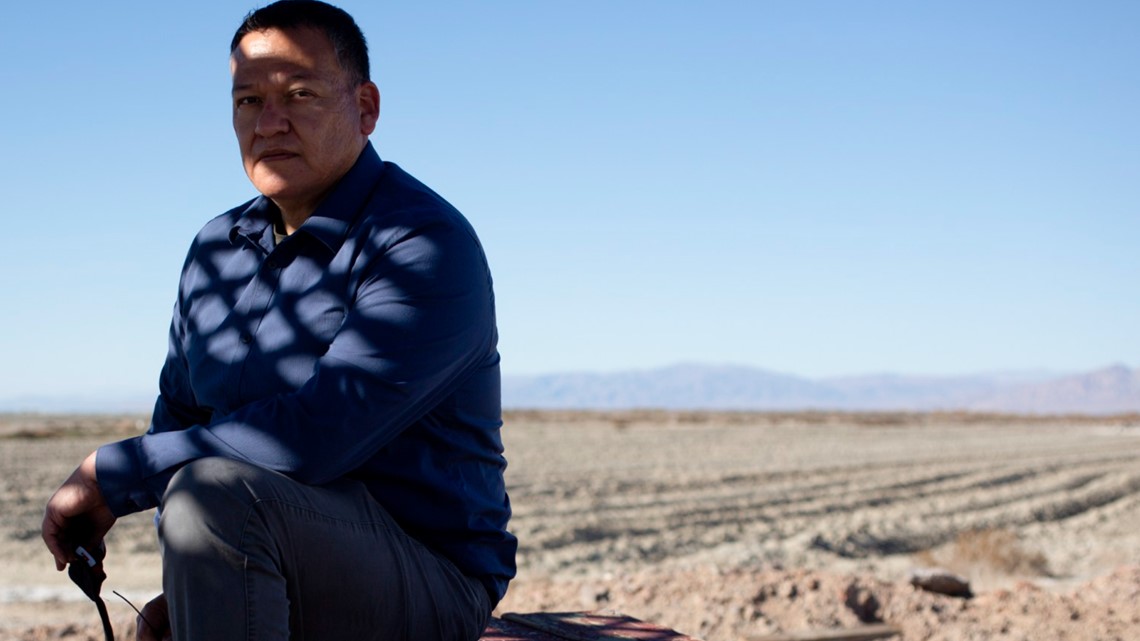
Imperial County planners exempted the lithium pilot project from environmental review requirements because the existing geothermal plant is already permitted. Full-scale commercial plants, however, would require environmental impact studies and new permits.
Most of the waste, which contains heavy metals, is reinjected in the ground from which it came, but some waste is held temporarily in ponds that are regulated by state officials to protect groundwater. The water board concluded that the lithium extraction would not alter the chemical properties of the waste, according to its 2020 report.
“We don’t anticipate any environmental issues,” Berkshire Hathaway Energy’s Weisgall said. Researchers at the Lawrence Berkeley National Laboratory and University of California, Riverside will test the demo project’s waste and emissions, he said.
Yet Katie Burnworth, who monitors the Salton Sea for the Imperial County Air Pollution Control District, said she worries that the waste might be hazardous. “It’s a dangerous, dirty process, with a lot of unknown material,” she said.
In 2006, CalEnergy’s geothermal facility was cited by state authorities for failing to properly dispose of hazardous materials after an inspection found elevated levels of arsenic and lead had been released into the environment. The company in 2007 entered into a consent agreement with state officials requiring a cleanup.
Another of the company’s power plants at the Salton Sea was fined by the air district for operating for seven years without an emissions permit.
The CalEnergy plants emit several toxic air pollutants, including hydrogen sulfide, ammonia and fine particles, according to state Air Resources Board reports.
Imperial County is eager to work with the industry to streamline the permitting process for lithium production.
“We’ve got to let them know that we want them here by making the permitting and planning process as least hard as it can be,” said Tim Kelley, CEO for the Imperial Valley Economic Development Corp., a public-private organization. “It’s never going to be easy and we want to make it easier for them.”
Unemployment in the rural county hovers at 18%, about twice the state average. “Our biggest exports are water, crops and people,” Kelley said. “We want the jobs.”
CalEnergy, which employs about 250 people, estimates it would double its workforce if lithium production takes off.
“The first thing they are dangling is jobs, said Eric Reyes, an organizer with the group Amigos de la Comunidad. “We are all for jobs. But we cannot let everyone do whatever they want. Our community has a history of bending over for industry. We need to be smarter now. We are on the cusp of environmental disaster.”
James C. Hanks, president of the Imperial Irrigation District, which leases land to three geothermal operations, welcomes the potential for growth, but said desert denizens are ever-watchful for speculators.
“The toughest part is sorting through and figuring out who’s the real deal or not,” said Hanks, who also serves on the state’s new Lithium Valley Commission.
Business as usual is not going to be acceptable this time, Olmedo said. Jobs and a healthy environment are the goals. Whatever economic boon the county has gained from past development has not improved life in the region’s poorest communities, he said.
“They’re not getting more libraries. They are not getting better schools. They are not getting better community services,’” Olmedo said. “They are not getting better health care. They are getting nothing but sickness and exposure to unhealthy conditions.
“We are fighting two fronts. One is supporting this huge opportunity. The other is whether those dollars are going to benefit the population of this region. Now the real work begins.”


